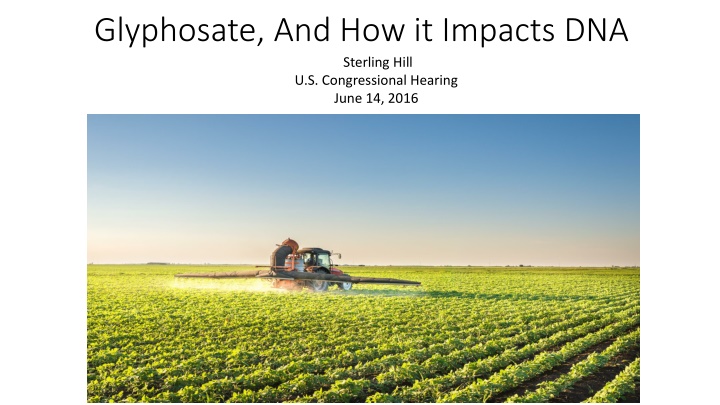
Glyphosate Impact on DNA and Health Concerns
Explore how glyphosate affects DNA and health, including the potential risks associated with glyoxylate accumulation and FUT2 non-secretors. Learn about DAO enzyme deficiency and its implications for various health conditions.
Download Presentation

Please find below an Image/Link to download the presentation.
The content on the website is provided AS IS for your information and personal use only. It may not be sold, licensed, or shared on other websites without obtaining consent from the author. If you encounter any issues during the download, it is possible that the publisher has removed the file from their server.
You are allowed to download the files provided on this website for personal or commercial use, subject to the condition that they are used lawfully. All files are the property of their respective owners.
The content on the website is provided AS IS for your information and personal use only. It may not be sold, licensed, or shared on other websites without obtaining consent from the author.
E N D
Presentation Transcript
Glyphosate, And How it Impacts DNA Sterling Hill U.S. Congressional Hearing June 14, 2016
FUT2 Since oxalate inhibits the breakdown of glyoxylate, which is a disintegration product of glyphosate, this would lead to an accumulation of glyoxylate, a strong glycating agent. Oxalobacter formigines, a resident gut species that degrades dietary oxalates, is associated with protection from hyperoxaluria. Akkermansia have -L-fucosidases, and -galactosidases allowing them to remove the terminal and other sugar moieties of the ABO (FUT2) histo-blood group antigens, whereas Oxalobacter, unable to grow on sugars , could benefit from end products of Akkermansia.
19% Of The Population Are FUT2 Non Secretors Creates a soluble precursor oligosaccharide FuC-alpha ((1,2)Galbeta-) called the H antigen which is an essential substrate for the final step in the soluble A and B antigen synthesis pathway. H and Se enzymes fucosylate the same acceptor substrates but exhibit different Km values.
DAO DAO s metabolic process part of glyoxylate. Glyoxylate accumulation in the cytosol is readily transformed by lactate dehydrogenase into oxalate, a dicarboxylic acid that cannot be metabolized by mammals and forms tissue-damaging calcium oxalate crystals. Catalyzes the degradation of compounds such as putrescine, histamine, spermine, and spermidine, substances involved in allergic and immune responses, cell proliferation, tissue differentiation, tumor formation, and possibly apoptosis. Placental DAO is thought to play a role in the regulation of the female reproductive function.
DAO Enzyme Deficiency Schizoprhenia Miscarriage Mast Cell Diarrhea Headache Rhinoconjunctival symptoms Asthma Hypotension Arrhythmia Urticaria Pruritus
